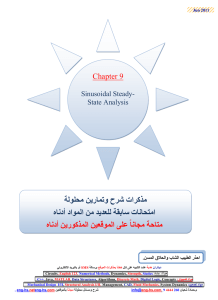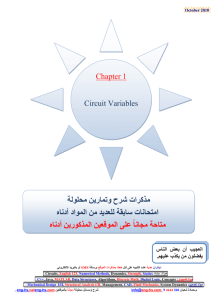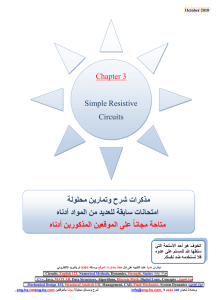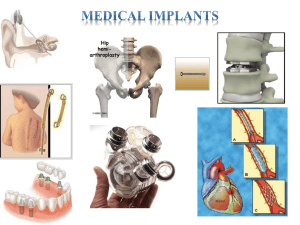Solution - eng
advertisement
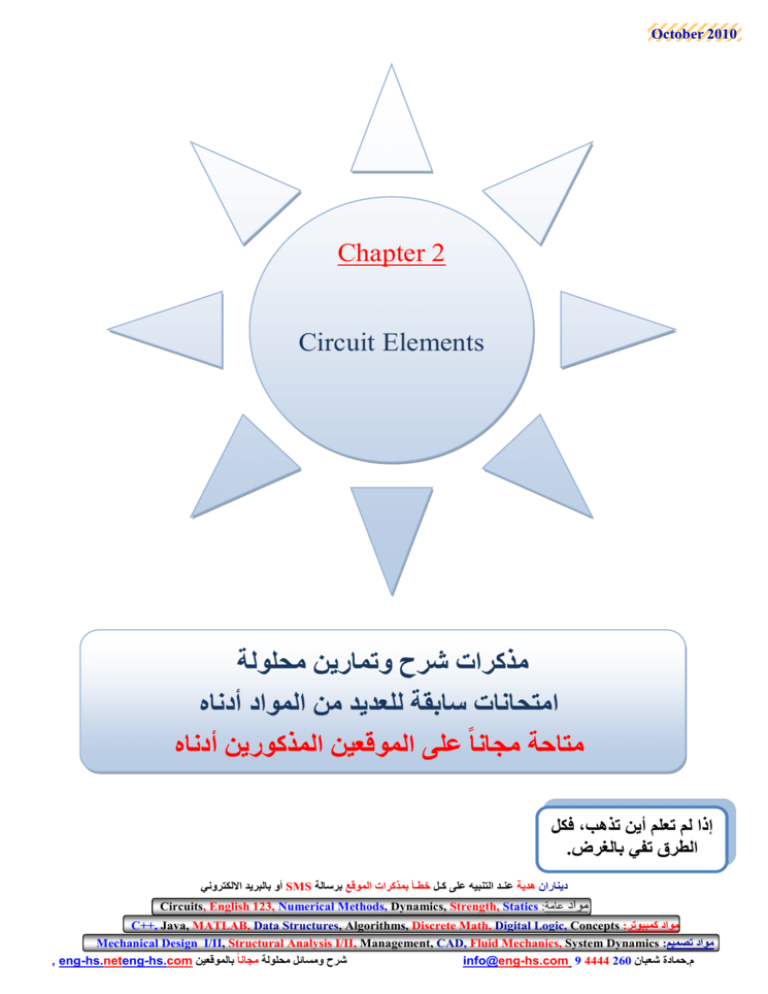
October 2010 Chapter 2 Circuit Elements مذكرات شرح وتمارين محلولة امتحانات سابقة للعديد من المواد أدناه متاحة مجانا على الموقعين المذكورين أدناه فكل،إذا لم تعلم أين تذهب .الطرق تفي بالغرض أو بالبريد االلكترونيSMS ديناران هدية عنـد التنبيه على كـل خطـأ بمذكرات الموقع برسالة Circuits, English 123, Numerical Methods, Dynamics, Strength, Statics :عامة مواد C++, Java, MATLAB, Data Structures, Algorithms, Discrete Math, Digital Logic, Concepts :مواد كمبيوتر Mechanical Design I/II, Structural Analysis I/II, Management, CAD, Fluid Mechanics, System Dynamics :مواد تصميم , eng-hs.neteng-hs.com شرح ومسائل محلولة مجانا بالموقعين info@eng-hs.com 9 4444 260 حمادة شعبان.م October 2010 Circuit elements: There are five ideal basic circuit elements: voltage sources, current sources, resistors, inductors, and capacitors. In this chapter we discuss the characteristics of voltage sources, current sources, and resistors. Inductors and capacitors will be discussed in Chapter 6, Where their use requires solving integral and differential equations. 2.1 Voltage and Current Sources An electrical source is a device that is capable of converting nonelectric energy to electric energy and vice versa. A discharging battery converts chemical energy to electric energy, whereas a battery being charged converts electric energy to chemical energy. A dynamo is a machine that converts mechanical energy to electric energy and vice versa. If operating in the mechanical-to-electric mode, it is called a generator. If transforming from electric to mechanical energy, it is referred to as a motor. The important thing to remember about these sources is that they can either deliver or absorb electric power. An ideal voltage source is a circuit element that maintains a prescribed voltage across its terminals regardless of the current in those terminals. An ideal current source is a circuit element that maintains a prescribed current through its terminals regardless of the voltage across those terminals. These circuit elements do not exist as practical devices, they are idealized models of actual voltage and current sources. من المهم أن يكون لديك .ما تستيقظ من أجله أو بالبريد االلكترونيSMS ديناران هدية عنـد التنبيه على كـل خطـأ بمذكرات الموقع برسالة Circuits, English 123, Numerical Methods, Dynamics, Strength, Statics :عامة مواد C++, Java, MATLAB, Data Structures, Algorithms, Discrete Math, Digital Logic, Concepts :مواد كمبيوتر Mechanical Design I/II, Structural Analysis I/II, Management, CAD, Fluid Mechanics, System Dynamics :مواد تصميم , eng-hs.neteng-hs.com شرح ومسائل محلولة مجانا بالموقعين info@eng-hs.com 9 4444 260 حمادة شعبان.م October 2010 An independent source establishes a voltage or current in a circuit without relying on voltages or currents elsewhere in the circuit. A dependent source establishes a voltage or current whose value depends on the value of some voltage or current elsewhere in the circuit. The circuit symbols for the ideal independent sources are shown in Fig. 2.1. The circuit symbols for the ideal dependent sources arc shown in Fig. 2.2. A diamond is used to represent a dependent source. Dependent sources are sometimes called controlled sources. In Fig. 2.2(a), the controlling voltage is named 𝑣𝑥 , the equation that determines the supplied voltage 𝑣𝑠 is: 𝑣𝑠 = 𝜇𝑣𝑥 µ is a multiplying constant that is dimensionless. .األماني رءوس أموال المفلسين أو بالبريد االلكترونيSMS ديناران هدية عنـد التنبيه على كـل خطـأ بمذكرات الموقع برسالة Circuits, English 123, Numerical Methods, Dynamics, Strength, Statics :عامة مواد C++, Java, MATLAB, Data Structures, Algorithms, Discrete Math, Digital Logic, Concepts :مواد كمبيوتر Mechanical Design I/II, Structural Analysis I/II, Management, CAD, Fluid Mechanics, System Dynamics :مواد تصميم , eng-hs.neteng-hs.com شرح ومسائل محلولة مجانا بالموقعين info@eng-hs.com 9 4444 260 حمادة شعبان.م October 2010 In Fig.2.2(b), the controlling current is 𝑖𝑥 , the equation for the supplied voltage 𝑣𝑠 is : 𝑣𝑠 = 𝜌𝑖𝑥 the multiplying constant ρ has the dimension volts per ampere. In Fig.2.2(c), the controlling voltage is 𝑣𝑥 , the equation for the supplied current 𝑖𝑠 is : 𝑖𝑠 = 𝛼𝑣𝑠 the multiplying constant α has the dimension amperes per volt. In Fig.2.2(d), the controlling current is 𝑖𝑥 , the equation for the supplied current 𝑖𝑠 is : 𝑖𝑠 = 𝛽𝑖𝑥 the multiplying constant β is dimensionless. An active element is one that models a device capable of generating electric energy (like voltage and current sources). Passive elements model physical devices that cannot generate electric energy Like Resistors, inductors, and capacitors لن تكون خاسرا أبدا إال عندما .تتوقف عن محاولة تحقيق الفوز أو بالبريد االلكترونيSMS ديناران هدية عنـد التنبيه على كـل خطـأ بمذكرات الموقع برسالة Circuits, English 123, Numerical Methods, Dynamics, Strength, Statics :عامة مواد C++, Java, MATLAB, Data Structures, Algorithms, Discrete Math, Digital Logic, Concepts :مواد كمبيوتر Mechanical Design I/II, Structural Analysis I/II, Management, CAD, Fluid Mechanics, System Dynamics :مواد تصميم , eng-hs.neteng-hs.com شرح ومسائل محلولة مجانا بالموقعين info@eng-hs.com 9 4444 260 حمادة شعبان.م October 2010 Example 2.1: Using the definitions of the ideal independent voltage and current sources, state which interconnections in Fig. 2.3 are permissible and which violate the constraints imposed by the ideal sources, Solution: Connection (a) is valid. Each source supplies voltage across terminals a, b. This requires that each source supply the same voltage with the same polarity to each terminal, which they do. Connection (b) is valid. Each source supplies current through terminals a, b. This requires that each source supply the same current to each terminal in the same direction, which they do. Connection (c) is not permissible. Each source supplies voltage across terminals a, b. This requires that each source supply the same voltage with the same polarity to each terminal, which they do not. Connection (d) is not permissible. Each source supplies current through terminals a, b. This requires that each source supply the same current to each terminal in the same direction, which they do not. Connection (e) is valid. The voltage source supplies voltage across terminals a, b. The current source supplies current through terminals. Because an ideal voltage source supplies the same voltage regardless of the current, and an ideal current source supplies the same current regardless of the voltage, this is a permissible connection. أو بالبريد االلكترونيSMS ديناران هدية عنـد التنبيه على كـل خطـأ بمذكرات الموقع برسالة Circuits, English 123, Numerical Methods, Dynamics, Strength, Statics :عامة مواد إذا انعدمت شهيتك .فـال تـلم الطعام C++, Java, MATLAB, Data Structures, Algorithms, Discrete Math, Digital Logic, Concepts :مواد كمبيوتر Mechanical Design I/II, Structural Analysis I/II, Management, CAD, Fluid Mechanics, System Dynamics :مواد تصميم , eng-hs.neteng-hs.com شرح ومسائل محلولة مجانا بالموقعين info@eng-hs.com 9 4444 260 حمادة شعبان.م October 2010 Example 2.2: Testing Interconnections of Ideal Independent and Dependent Sources Using the definitions of the ideal independent and dependent sources, state which interconnections in Fig. 2.4 are valid and which violate the constraints imposed by the ideal sources. Solution: Connection (a) is invalid. Both the independent source and the dependent source supply voltage across terminals a, b. This requires that each source supply the same voltage with the same polarity. The independent source supplies 5 V, but the dependent source supplies 15 V. Connection (b) is valid. The independent voltage source supplies voltage across terminals a, b. The dependent current source supplies current through the same terminals. Because an ideal voltage source supplies the same voltage regardless of current, and an ideal current source supplies the same current regardless of voltage, this is an allowable connection. Connection (c) is valid. Same as (b). Connection (d) is invalid. Both the independent source and the dependent source supply current through terminals a, b. This requires that each source supply the same current in the same reference direction. The independent source supplies 2 A, but the dependent source supplies 6 A in the opposite direction. .أفضل وسيلة للبر بالوعد أن ال تعد أو بالبريد االلكترونيSMS ديناران هدية عنـد التنبيه على كـل خطـأ بمذكرات الموقع برسالة Circuits, English 123, Numerical Methods, Dynamics, Strength, Statics :عامة مواد C++, Java, MATLAB, Data Structures, Algorithms, Discrete Math, Digital Logic, Concepts :مواد كمبيوتر Mechanical Design I/II, Structural Analysis I/II, Management, CAD, Fluid Mechanics, System Dynamics :مواد تصميم , eng-hs.neteng-hs.com شرح ومسائل محلولة مجانا بالموقعين info@eng-hs.com 9 4444 260 حمادة شعبان.م October 2010 Assessment 2.1: For the circuit shown, a) What value of 𝑣𝑔 is required in order for the interconnection to be valid? b) For this value of 𝑣𝑔 , find the power associated with the 8 A source. Solution: a) 𝑖𝑏 is same like 8 A but in opposite direction. 𝑖𝑏 = − 8 A the dependent voltage source 𝑖𝑏 4 and the independent voltage source vg are in parallel and with same polarity. 𝑣𝑔 = 𝑖𝑏 − 8 = = −2 V 4 4 b) 𝑃8𝐴 = 𝑣𝑖 = −2 × 8 = −16 W (delivers) إن ثقتك بنفسك وراحة قلبك أكثر أهمية من .نظرة الناس لك ومن كل فروض العالم أو بالبريد االلكترونيSMS ديناران هدية عنـد التنبيه على كـل خطـأ بمذكرات الموقع برسالة Circuits, English 123, Numerical Methods, Dynamics, Strength, Statics :عامة مواد C++, Java, MATLAB, Data Structures, Algorithms, Discrete Math, Digital Logic, Concepts :مواد كمبيوتر Mechanical Design I/II, Structural Analysis I/II, Management, CAD, Fluid Mechanics, System Dynamics :مواد تصميم , eng-hs.neteng-hs.com شرح ومسائل محلولة مجانا بالموقعين info@eng-hs.com 9 4444 260 حمادة شعبان.م October 2010 Assessment 2.2: For the circuit shown, a) What value of α is required in order for the interconnection to be valid? b) For the value of α calculated in part(a), find the power associated with the 25 V source. Solution: a) The independent and dependent current sources are in same branch, So they should be equal. 𝑣𝑥 = − 25 ∝ 𝑣𝑥 = − 15 ∝= b) 𝑃25𝑣 = − 15 = 0.6 − 25 𝑣 𝑖 = 25 × 15 = 375 W (absorbs) OR 𝑃25𝑣 = − 𝑣 𝑖 = − (25) × (− 15) = 375 W (absorbs, same result) مارس رياضة المشي في الصباح .الباكر وتأمل الطبيعة من حولك أو بالبريد االلكترونيSMS ديناران هدية عنـد التنبيه على كـل خطـأ بمذكرات الموقع برسالة Circuits, English 123, Numerical Methods, Dynamics, Strength, Statics :عامة مواد C++, Java, MATLAB, Data Structures, Algorithms, Discrete Math, Digital Logic, Concepts :مواد كمبيوتر Mechanical Design I/II, Structural Analysis I/II, Management, CAD, Fluid Mechanics, System Dynamics :مواد تصميم , eng-hs.neteng-hs.com شرح ومسائل محلولة مجانا بالموقعين info@eng-hs.com 9 4444 260 حمادة شعبان.م October 2010 Question 2.1: a) Is the interconnection of ideal sources in the circuit in Fig. P2.1 valid? Explain, b) Identify which sources are developing power and which sources are absorbing power. c) Verify that the total power developed in the circuit equals the total power absorbed. d) Repeat (a)-(c), reversing the polarity of the 10 V source. Solution: a) Yes, independent voltage sources can carry the 8 A current required by the connection; independent current source can support any voltage required by the connection, in this case 20 V, positive at the top. b) 30 V source: absorbing. 10 V source: delivering. 8 A source: delivering. c) P30V = (30)(8) = 240 P10V = −(10)(8) = − 80 P8A = −(20)(8) = − 160 ∑ Pabs = ∑ Pdel = 240 W W W W (abs) (del) (del) d) The interconnection is valid, but in this circuit the voltage drop across the 8 A current source is 40 V, positive at the top; 30 V source is absorbing, the 10 V source is absorbing, and the 8 A source is delivering P30V = (30)(8) = 240 W (abs) P10V = (10)(8) = 80 W (abs) P8A = −(40)(8) = − 320 W (del) حاول أن تنمي مهارة اإلبداع لديك ∑ Pabs = ∑ Pdel = 320 W .واعلم أنها مهارة تستطيع أن تكتسبها أو بالبريد االلكترونيSMS ديناران هدية عنـد التنبيه على كـل خطـأ بمذكرات الموقع برسالة Circuits, English 123, Numerical Methods, Dynamics, Strength, Statics :عامة مواد C++, Java, MATLAB, Data Structures, Algorithms, Discrete Math, Digital Logic, Concepts :مواد كمبيوتر Mechanical Design I/II, Structural Analysis I/II, Management, CAD, Fluid Mechanics, System Dynamics :مواد تصميم , eng-hs.neteng-hs.com شرح ومسائل محلولة مجانا بالموقعين info@eng-hs.com 9 4444 260 حمادة شعبان.م October 2010 Question 2.2: If the interconnection in Fig. P2.2 is valid, find the power developed by the current sources. If the interconnection is not valid, explain why. Solution: The interconnection is valid and the voltage and current in the circuit are shown in figure: 𝑃10𝐴 = − (100)(10) = − 1000 W (dev) 𝑃5𝐴 = − (140)(5) = − 700 (dev) W ∑ 𝑃𝑑𝑒𝑣 = 1700 W خصص خمس دقائق للتخيل .صباح ومساء كل يوم أو بالبريد االلكترونيSMS ديناران هدية عنـد التنبيه على كـل خطـأ بمذكرات الموقع برسالة Circuits, English 123, Numerical Methods, Dynamics, Strength, Statics :عامة مواد C++, Java, MATLAB, Data Structures, Algorithms, Discrete Math, Digital Logic, Concepts :مواد كمبيوتر Mechanical Design I/II, Structural Analysis I/II, Management, CAD, Fluid Mechanics, System Dynamics :مواد تصميم , eng-hs.neteng-hs.com شرح ومسائل محلولة مجانا بالموقعين info@eng-hs.com 9 4444 260 حمادة شعبان.م October 2010 Question 2.3: If the interconnection in Fig. P2.3 is valid, find the total power developed by the voltage sources. If the interconnection is not valid, explain why. Solution: The 4 A and 5 A current sources in the right branch should supply the same current in the same direction, so the interconnection is not valid. األمور الصعبة تشبه قيادة السيارة في تستطيع الرؤية بقدر ما تكشفه،ظالم الليل .أنوار السيارة لكنك غالبا ستكمل الرحلة أو بالبريد االلكترونيSMS ديناران هدية عنـد التنبيه على كـل خطـأ بمذكرات الموقع برسالة Circuits, English 123, Numerical Methods, Dynamics, Strength, Statics :عامة مواد C++, Java, MATLAB, Data Structures, Algorithms, Discrete Math, Digital Logic, Concepts :مواد كمبيوتر Mechanical Design I/II, Structural Analysis I/II, Management, CAD, Fluid Mechanics, System Dynamics :مواد تصميم , eng-hs.neteng-hs.com شرح ومسائل محلولة مجانا بالموقعين info@eng-hs.com 9 4444 260 حمادة شعبان.م October 2010 Question 2.4: If the interconnection in Fig. P2.4 is valid, find the total power developed in the circuit. If the interconnection is not valid, explain why. Solution: The interconnect is valid since the voltage sources can carry 5 A of current supplied by the current source, and the current source can carry the voltage drop required by the interconnection. Note that the branch containing the 10 V, 40 V, and 5 A sources must have the same voltage drop as the branch containing the 50 V source, so the 5 A current source must have a voltage drop of 20 V, positive at the right. The voltages and currents are summarized in the circuit shown: P50V = (50)(5) = 250 W (abs) P10V = (10)(5) = 50 W (abs) P40V = −(40)(5) = − 200 W (dev) P5A = −(20)(5) = − 100 W (dev) ∑ 𝑃𝑑𝑒𝑣 = 300 W تخيل نفسك وزيرا لمدة يوم ماذا ستقرر؟،واحد بوزارة هامة أو بالبريد االلكترونيSMS ديناران هدية عنـد التنبيه على كـل خطـأ بمذكرات الموقع برسالة Circuits, English 123, Numerical Methods, Dynamics, Strength, Statics :عامة مواد C++, Java, MATLAB, Data Structures, Algorithms, Discrete Math, Digital Logic, Concepts :مواد كمبيوتر Mechanical Design I/II, Structural Analysis I/II, Management, CAD, Fluid Mechanics, System Dynamics :مواد تصميم , eng-hs.neteng-hs.com شرح ومسائل محلولة مجانا بالموقعين info@eng-hs.com 9 4444 260 حمادة شعبان.م October 2010 2.2 Electrical Resistance (Ohm's Law): Resistance is the capacity of materials to resist the flow of current. the relationship between the voltage and current is 𝑣 = 𝑖𝑅 where: 𝑣 = the voltage in volts, 𝑖 = the current in amperes, 𝑅 = the resistance in ohms. In SI units, resistance is measured in ohms. The reciprocal of the resistance is referred to as conductance, is symbolized by the letter G, and is measured in Siemens (S). Thus 𝐺= 1 S 𝑅 An 8 Ω resistor has a conductance value of 0.125 S, we may also describe an 8 Ω resistor as having a conductance of 0.125 mho. Power and resistor relationship: 𝑣2 𝑖2 2 𝑃 = 𝑣𝑖 = = 𝑖 𝑅= 𝑅 𝐺 .حيث يغيب النـمر يغـدو األرنب ملكا أو بالبريد االلكترونيSMS ديناران هدية عنـد التنبيه على كـل خطـأ بمذكرات الموقع برسالة Circuits, English 123, Numerical Methods, Dynamics, Strength, Statics :عامة مواد C++, Java, MATLAB, Data Structures, Algorithms, Discrete Math, Digital Logic, Concepts :مواد كمبيوتر Mechanical Design I/II, Structural Analysis I/II, Management, CAD, Fluid Mechanics, System Dynamics :مواد تصميم , eng-hs.neteng-hs.com شرح ومسائل محلولة مجانا بالموقعين info@eng-hs.com 9 4444 260 حمادة شعبان.م October 2010 Example 2.3: Calculating Voltage, Current, and Power for a Simple Resistive Circuit In each circuit in Fig. 2.8, either the value of 𝑣 or 𝑖 is not known. a) Calculate the values of 𝑣 and 𝑖. b) Determine the power dissipated in each resistor. Solution: a) The voltage 𝑣𝑎 is a drop in the direction of the current in the resistor. Therefore, 𝑣𝑎 = (1)(8) = 8 V The current 𝑖𝑏 is in the direction of the voltage drop across the resistor. Thus, 𝑖𝑏 = (50)(0.2) = 10 A The voltage 𝑣𝑐 is a rise in the direction of the current in the resistor, Hence 𝑣𝑐 = −(1)(20) = − 20 V The current 𝑖𝑑 is in the direction of the voltage rise across the resistor. Therefore − 50 𝑖𝑑 = =−2 A 25 b) 𝑝8Ω 𝑝8Ω 𝑝0.2Ω 𝑝20Ω 𝑝25Ω = 𝑣𝑖 =8×1 =8 = 50 × 10 = 500 = 20 × 1 = 20 = 50 × 2 = 100 W W W W الرسومات واألشكال التوضيحية تفوق الكتابة .عشرات المرات في عرض المعلومات أو بالبريد االلكترونيSMS ديناران هدية عنـد التنبيه على كـل خطـأ بمذكرات الموقع برسالة Circuits, English 123, Numerical Methods, Dynamics, Strength, Statics :عامة مواد C++, Java, MATLAB, Data Structures, Algorithms, Discrete Math, Digital Logic, Concepts :مواد كمبيوتر Mechanical Design I/II, Structural Analysis I/II, Management, CAD, Fluid Mechanics, System Dynamics :مواد تصميم , eng-hs.neteng-hs.com شرح ومسائل محلولة مجانا بالموقعين info@eng-hs.com 9 4444 260 حمادة شعبان.م October 2010 2.4 Kirchhoff’s Laws: A node is a point where two or more circuit elements meet. Kirchhoff's current law (KCL): The algebraic sum of all the currents at any node in a circuit equals zero. In any circuit with n nodes, n - 1 independent current equations can be derived from Kirchhoff's current law. A closed path or loop: Starting at an arbitrarily selected node, we trace a closed path in a circuit through selected basic circuit elements and return to original node without re-passing through any intermediate. Kirchhoff's voltage Law (KVL): The algebraic sum of all the voltages around any closed path in a circuit equals zero. Think about a circuit analysis strategy before beginning to write equations. not every closed path provides an opportunity to write a useful equation based on Kirchhoff's voltage law. Not every node provides for a useful application of Kirchhoff's current law. Some preliminary thinking can help in selecting the most useful analysis tools for a particular problem. .احلم وتصور النجاح دائما أو بالبريد االلكترونيSMS ديناران هدية عنـد التنبيه على كـل خطـأ بمذكرات الموقع برسالة Circuits, English 123, Numerical Methods, Dynamics, Strength, Statics :عامة مواد C++, Java, MATLAB, Data Structures, Algorithms, Discrete Math, Digital Logic, Concepts :مواد كمبيوتر Mechanical Design I/II, Structural Analysis I/II, Management, CAD, Fluid Mechanics, System Dynamics :مواد تصميم , eng-hs.neteng-hs.com شرح ومسائل محلولة مجانا بالموقعين info@eng-hs.com 9 4444 260 حمادة شعبان.م October 2010 Example 2.6: Using Kirchhoff's Current Law Sum the currents at each node in the circuit shown in Fig. 2.16. Note that there is no connection dot (•) in the center of the diagram, where the 4 Ω branch crosses the branch containing the ideal current source 𝑖𝑎 . Solution: In writing the equations, we use a positive sign for a current leaving a node. The four equations are: node a: 𝑖1 + 𝑖4 − 𝑖2 − 𝑖5 = 0 node b: 𝑖2 + 𝑖3 − 𝑖1 − 𝑖𝑏 − 𝑖𝑎 = 0 node c: 𝑖𝑏 − 𝑖3 − 𝑖4 − 𝑖𝑐 = 0 node d: 𝑖5 + 𝑖𝑎 + 𝑖𝑐 = 0 إن لم تكن األفضل اآلن .فثق أن األمر مسألة وقت أو بالبريد االلكترونيSMS ديناران هدية عنـد التنبيه على كـل خطـأ بمذكرات الموقع برسالة Circuits, English 123, Numerical Methods, Dynamics, Strength, Statics :عامة مواد C++, Java, MATLAB, Data Structures, Algorithms, Discrete Math, Digital Logic, Concepts :مواد كمبيوتر Mechanical Design I/II, Structural Analysis I/II, Management, CAD, Fluid Mechanics, System Dynamics :مواد تصميم , eng-hs.neteng-hs.com شرح ومسائل محلولة مجانا بالموقعين info@eng-hs.com 9 4444 260 حمادة شعبان.م October 2010 Example 2.7: Using Kirchhoffs Voltage Law Sum the voltages around each designated path in the circuit shown in Fig. 2.17. Solution: In writing the equations, we use a positive sign for a voltage drop. The four equations are: path a: −𝑣1 + 𝑣2 + 𝑣4 − 𝑣𝑏 − 𝑣3 = 0 path b: −𝑣𝑎 + 𝑣3 + 𝑣5 = 0 path c: 𝑣𝑏 − 𝑣4 − 𝑣𝑐 − 𝑣6 − 𝑣5 = 0 path d: −𝑣𝑎 − 𝑣1 + 𝑣2 − 𝑣𝑐 + 𝑣7 − 𝑣𝑑 = 0 فكر بحل مكلف لمشكلة ما ثم .حاول تحديد إيجابيات ذلك الحل أو بالبريد االلكترونيSMS ديناران هدية عنـد التنبيه على كـل خطـأ بمذكرات الموقع برسالة Circuits, English 123, Numerical Methods, Dynamics, Strength, Statics :عامة مواد C++, Java, MATLAB, Data Structures, Algorithms, Discrete Math, Digital Logic, Concepts :مواد كمبيوتر Mechanical Design I/II, Structural Analysis I/II, Management, CAD, Fluid Mechanics, System Dynamics :مواد تصميم , eng-hs.neteng-hs.com شرح ومسائل محلولة مجانا بالموقعين info@eng-hs.com 9 4444 260 حمادة شعبان.م October 2010 Example 2.8: Applying Ohm's Law and Kirchhoff's Laws to Find an Unknown Current a) Use Kirchhoff's laws and Ohm's law to find 𝑖𝑜 in the circuit shown in Fig. 2.18. b) Test the solution for 𝑖𝑜 by verifying that the total power generated equals the total power dissipated. Solution: Redrawing the circuit and assigning an unknown current to the 50 Ω resistor and unknown voltages across the 10 Ω and 50 Ω resistors. The nodes are labeled a, b, and c to aid the discussion. Summing the currents at node b: 𝑖1 − 𝑖0 − 6 = 0 Summing the voltages around the closed path (cabc) to obtain: −120 + 10 𝑖0 + 50 𝑖1 = 0 Solving these two equations: 𝑖0 = −3 A and The power dissipated in 50 Ω is: 𝑝50Ω = (3)2 (50) 𝑖1 = 3 A, 𝑣1 = 150 V = 450 W The power dissipated in 10 Ω is: 𝑝10Ω = (− 3)2 (10) = 90 W The power delivered to the 120 V source is: 𝑝120V = 120𝑖0 = 120(3) = 360 W The power delivered by the 6 A source: 𝑝6A = 150(6) = 900 W total power absorbed is 360 + 450 + 90 = 900 W جرب واختبر األشياء .وشجع على التجربة أو بالبريد االلكترونيSMS ديناران هدية عنـد التنبيه على كـل خطـأ بمذكرات الموقع برسالة Circuits, English 123, Numerical Methods, Dynamics, Strength, Statics :عامة مواد C++, Java, MATLAB, Data Structures, Algorithms, Discrete Math, Digital Logic, Concepts :مواد كمبيوتر Mechanical Design I/II, Structural Analysis I/II, Management, CAD, Fluid Mechanics, System Dynamics :مواد تصميم , eng-hs.neteng-hs.com شرح ومسائل محلولة مجانا بالموقعين info@eng-hs.com 9 4444 260 حمادة شعبان.م October 2010 Assessment problem 2.6: Use Ohm's law and Kirchhoff's laws to find the value of 𝑅 in the circuit shown. Solution: Applying KVL for the left loop: −200 + 𝑖1 𝑅 + 120 = 0 𝑖1 𝑅 = 80 a Applying KVL for the outer loop: −200 + 𝑖1 𝑅 + 8𝑖3 = 0 −200 + 80 + 8𝑖3 = 0 𝑖3 = 15 𝐴 Applying ohm’s law for resistor 24 Ω: 𝑖2 = 120 24 =5 A Applying KCL at upper middle node (a): −𝑖1 + 𝑖2 + 𝑖3 = 0 𝑖1 = 20 A 𝑖1 𝑅 = 80, 𝑅 =4Ω ،قبل أن تقرر أي شيء .استعرض الخيارات المتاحة أو بالبريد االلكترونيSMS ديناران هدية عنـد التنبيه على كـل خطـأ بمذكرات الموقع برسالة Circuits, English 123, Numerical Methods, Dynamics, Strength, Statics :عامة مواد C++, Java, MATLAB, Data Structures, Algorithms, Discrete Math, Digital Logic, Concepts :مواد كمبيوتر Mechanical Design I/II, Structural Analysis I/II, Management, CAD, Fluid Mechanics, System Dynamics :مواد تصميم , eng-hs.neteng-hs.com شرح ومسائل محلولة مجانا بالموقعين info@eng-hs.com 9 4444 260 حمادة شعبان.م October 2010 Question 2.18: Given the circuit shown in Fig. P2.18, find a) the value of 𝑖𝑎 , b) the value of 𝑖𝑏 , c) the value of 𝑣𝑜 , d) the power dissipated in each resistor, e) the power delivered by the 50 V source. Solution: a a, b) Applying KVL for the right loop: −20 𝑖𝑎 + 80 𝑖𝑏 = 0 𝑖𝑎 = 4 𝑖𝑏 Applying KVL for the left loop: − 50 + 4 𝑖𝑔 + 20 𝑖𝑎 = 0 Applying KCL for node (a): − 𝑖𝑔 + 𝑖𝑎 + 𝑖𝑏 = 0 Solving, 𝑖𝑎 = 2 A, 𝑖𝑏 = 0.5 A, c) 𝑣0 = 20 𝑖𝑎 = 40 V 𝑖𝑔 = 2.5 A OR 𝑖𝑜 = 80𝑖𝑏 = 40 V d) 𝑝 = 𝑖 2 𝑅 𝑝4Ω = (2.5)2 × 4 = 25 W 𝑝20Ω = (2)2 × 20 = 80 W 𝑝80Ω = (0.5)2 × 80 = 20 W e) 𝑝50V = 𝑣𝑖 = 50 × 2.5 = 125 W .تعلم رياضة جديدة حتى إن لم تمارسها أو بالبريد االلكترونيSMS ديناران هدية عنـد التنبيه على كـل خطـأ بمذكرات الموقع برسالة Circuits, English 123, Numerical Methods, Dynamics, Strength, Statics :عامة مواد C++, Java, MATLAB, Data Structures, Algorithms, Discrete Math, Digital Logic, Concepts :مواد كمبيوتر Mechanical Design I/II, Structural Analysis I/II, Management, CAD, Fluid Mechanics, System Dynamics :مواد تصميم , eng-hs.neteng-hs.com شرح ومسائل محلولة مجانا بالموقعين info@eng-hs.com 9 4444 260 حمادة شعبان.م October 2010 Question 2.21: The current 𝑖𝑜 in the circuit in Fig. P2.21 is 4 A. a) Find 𝑖1 . b) Find the power dissipated in each resistor. c) Verify that the total power dissipated in the circuit equals the power developed by the 180 V source. Solution: a) Applying KVL for the outer loop: −180 + 25 𝑖0 + 8 𝑖2 = 0 𝑖2 = 10 A Appluing KCL at node (a): a −𝑖0 − 𝑖3 + 𝑖2 = 0 𝑖3 = 6 A Applying KVL for the right loop: −70 𝑖1 + 10 𝑖3 + 8 𝑖2 = 0 𝑖1 = 2 A By applying KCL at the intermediate node 𝑖4 = 8 A b) 𝑝5𝛺 = (8)2 (5) = 320 W 𝑝25𝛺 = (4)2 (25) = 400 W 𝑝70𝛺 = (2)2 (70) = 280 W 𝑝10𝛺 = (6)2 (10) = 360 W 𝑝8𝛺 = (10)2 (8) = 800 W c) ∑ 𝑃𝑑𝑖𝑠 = 320 + 400 + 280 + 360 + 800 = 2160 W 𝑃𝑑𝑒𝑣 = 180 𝑖𝑔 = (180)(12) = 2160 W غير طريقك من وإلى . ربما تكتشف جديدا،عملك أو بالبريد االلكترونيSMS ديناران هدية عنـد التنبيه على كـل خطـأ بمذكرات الموقع برسالة Circuits, English 123, Numerical Methods, Dynamics, Strength, Statics :عامة مواد C++, Java, MATLAB, Data Structures, Algorithms, Discrete Math, Digital Logic, Concepts :مواد كمبيوتر Mechanical Design I/II, Structural Analysis I/II, Management, CAD, Fluid Mechanics, System Dynamics :مواد تصميم , eng-hs.neteng-hs.com شرح ومسائل محلولة مجانا بالموقعين info@eng-hs.com 9 4444 260 حمادة شعبان.م October 2010 Question 2.22: For the circuit shown in Fig. P2.22, find (a) 𝑅 and (b) the power supplied by the 125 V source. Solution: a) Applying KVL for the outer loop: − 125 + (3 × 9) + (3 × 6) + (𝑖𝑒 × 10) + (𝑖𝑒 × 6) = 0 𝑖𝑒 = 5 A c Applying KCL at node (a): − 3 − 𝑖𝑑 + 𝑖𝑒 = 0 𝑖𝑑 = 2 A b a Applying KVL for the right bottom loop: −30 𝑖𝑐 + 5 𝑖𝑑 + 10 𝑖𝑒 + 6 𝑖𝑒 = 0 𝑖𝑐 = 3 A Applying KCL at node (b): − 𝑖𝑎 + 𝑖𝑑 + 𝑖𝑐 = 0 𝑖𝑎 = 5 A Applying KVL for the left loop: −125 + 𝑖𝑎 𝑅 + 30𝑖𝑐 = 0 𝑅=7 Ω Applying KCL at node (c): − 𝑖𝑔 + 𝑖𝑎 + 3 = 0 𝑖𝑔 = 8 A b) 𝑃125V = 𝑣𝑖 = 125 × 8 = 1000 W (delivers) أما من،ربما ندم من لم يتزوج .تزوج فال مناص له من الندم أو بالبريد االلكترونيSMS ديناران هدية عنـد التنبيه على كـل خطـأ بمذكرات الموقع برسالة Circuits, English 123, Numerical Methods, Dynamics, Strength, Statics :عامة مواد C++, Java, MATLAB, Data Structures, Algorithms, Discrete Math, Digital Logic, Concepts :مواد كمبيوتر Mechanical Design I/II, Structural Analysis I/II, Management, CAD, Fluid Mechanics, System Dynamics :مواد تصميم , eng-hs.neteng-hs.com شرح ومسائل محلولة مجانا بالموقعين info@eng-hs.com 9 4444 260 حمادة شعبان.م October 2010 Question 2.25: The currents 𝑖𝑎 and 𝑖𝑏 in the circuit in Fig. P2.25 are 4 A and 2 A, respectively. a) Find 𝑖𝑔 . b) Find the power dissipated in each resistor. c) Find 𝑣𝑔 . d) Show that the power delivered by the current source is equal to the power absorbed by all the other elements. Solution: a, c) Applying KCL at node (a): a 2 + 4 − 𝑖4 = 0 → 𝑖4 = 6 A Applying KVL for the left loop: −80 − 4 𝑖4 + 𝑣𝑔 − 12 × 4 = 0 → 𝑣𝑔 = 152 V Applying KVL for the outer loop: b −80 + (8 + 12 + 4) × 2 + (6 + 10) × 𝑖1 − 12 × 4 = 0 → 𝑖1 = 5 A Applying KCL at node (b): − 4 − 𝑖𝑔 − 𝑖1 = 0 → 𝑖𝑔 = − 9 A b) 𝑝 = 𝑅𝑖 2 𝑝8 Ω 𝑝4 Ω 𝑝24 Ω 𝑝10 Ω = (8)(2)2 = 32 = (4)(2)2 = 16 = (24)(3)2 = 216 = (10)(5)2 = 250 W; W; W; W; 𝑝12 Ω = (12)(2)2 𝑝4 Ω = (4)(6)2 𝑝6 Ω = (6)(5)2 𝑝12 Ω = (12)(4)2 = 48 = 144 = 150 = 192 W W W W d) Sum the power dissipated by the resistors: ∑ 𝑝𝑑𝑖𝑠𝑠 = 32 + 48 + 16 + 144 + 216 + 150 + 250 + 192 = 1048 W The power associated with the sources is: 𝑝𝑣𝑜𝑙𝑡−𝑠𝑜𝑢𝑟𝑐𝑒 = (80)(4) = 320 W (absorbs) 𝑝𝑐𝑢𝑟𝑟−𝑠𝑜𝑢𝑟𝑐𝑒 = 𝑣𝑔 𝑖𝑔 = (152)(−9) = −1368 W (delivers) Thus the total power dissipated is 1048 + 320 = 1368 W, equals the total power developed is 1368 W ،قم بخطوات صغيرة في كل عمل .وال تكتفي بالكالم واألماني أو بالبريد االلكترونيSMS ديناران هدية عنـد التنبيه على كـل خطـأ بمذكرات الموقع برسالة Circuits, English 123, Numerical Methods, Dynamics, Strength, Statics :عامة مواد C++, Java, MATLAB, Data Structures, Algorithms, Discrete Math, Digital Logic, Concepts :مواد كمبيوتر Mechanical Design I/II, Structural Analysis I/II, Management, CAD, Fluid Mechanics, System Dynamics :مواد تصميم , eng-hs.neteng-hs.com شرح ومسائل محلولة مجانا بالموقعين info@eng-hs.com 9 4444 260 حمادة شعبان.م October 2010 Question 2.28: a) Find the voltage 𝑣𝑦 in the circuit in Fig. P2.28. b) Show that the total power generated in the circuit equals the total power absorbed. Solution: a) Applying KCL at node (a) leads that current in the 200 Ω resistor is 30𝑖𝐵 Applying KVL for the left loop: a − 15.2 + 10,000 𝑖𝛽 − 0.8 + 200 × (30 𝑖𝛽 ) = 0 𝑖𝛽 = 1 × 10−3 A Applying KVL for the right loop: −25 + 500 × (29 𝑖𝛽 ) + 𝑣𝑦 + 200 × (30 𝑖𝛽 ) = 0 𝑣𝑦 = 4.5 V b) Element Current (mA) Power Equation Power (mW) 15.2 V 1 𝑝 = − 𝑣𝑖 10 kΩ 1 𝑝= 0.8 V 1 𝑝 = − 𝑣𝑖 Ω 30 𝑝= 𝑅𝑖 2 180 Depen. Source 29 𝑝= 𝑣𝑖 130.5 500 Ω 29 𝑝= 𝑅𝑖 2 420.5 25 V 29 𝑝 = − 𝑣𝑖 200 ∑ 𝑃𝑔𝑒𝑛𝑒𝑟𝑎𝑡𝑒𝑑 = − 15.2 − 0.8 − 725 𝑅𝑖 2 10 − 0.8 − 725 = − 741 mW ∑ 𝑃𝑎𝑏𝑠𝑜𝑟𝑏𝑒𝑑 = 10 + 180 + 130.5 + 420.5 = Both are equals. − 15.2 741 mW فكر بعملل،إذا كان لديك وقت فراغ .شيء إبداعي ينفعك في مستقبلك أو بالبريد االلكترونيSMS ديناران هدية عنـد التنبيه على كـل خطـأ بمذكرات الموقع برسالة Circuits, English 123, Numerical Methods, Dynamics, Strength, Statics :عامة مواد C++, Java, MATLAB, Data Structures, Algorithms, Discrete Math, Digital Logic, Concepts :مواد كمبيوتر Mechanical Design I/II, Structural Analysis I/II, Management, CAD, Fluid Mechanics, System Dynamics :مواد تصميم , eng-hs.neteng-hs.com شرح ومسائل محلولة مجانا بالموقعين info@eng-hs.com 9 4444 260 حمادة شعبان.م October 2010 Question 2.29: Find (a) 𝑖𝑜 , (b) 𝑖1 , and (c) 𝑖2 in the circuit in Fig. P2.29. Solution: a) No current can occurs in an open loop, so 𝑖0 = 0 b, c) Applying KVL for the left loop: − 60 + 𝑖𝑔 × (1000 + 5000) = 0 𝑖𝑔 = 10 mA 𝑣∆ = (5 × 103 ) × (10 × 10−3 ) = 50 V a Applying KVL for the right loop: 𝑖2 × 500 − 𝑖1 × 2000 = 0 𝑖2 = 4 𝑖1 Applying KCL at node (a): −6 × 10−3 𝑣∆ − 𝑖1 − 𝑖2 = 0 𝑖1 + 𝑖2 = − 0.3 By solving, 𝑖1 = − 0.06 A = − 60 mA 𝑖2 = − 0.24 A = − 240 mA احرص أن يكون في أي عمل .تعمله شيء من اإلبداع أو بالبريد االلكترونيSMS ديناران هدية عنـد التنبيه على كـل خطـأ بمذكرات الموقع برسالة Circuits, English 123, Numerical Methods, Dynamics, Strength, Statics :عامة مواد C++, Java, MATLAB, Data Structures, Algorithms, Discrete Math, Digital Logic, Concepts :مواد كمبيوتر Mechanical Design I/II, Structural Analysis I/II, Management, CAD, Fluid Mechanics, System Dynamics :مواد تصميم , eng-hs.neteng-hs.com شرح ومسائل محلولة مجانا بالموقعين info@eng-hs.com 9 4444 260 حمادة شعبان.م October 2010 Question 2.30: Find 𝑣1 and 𝑣𝑔 in the circuit shown in Fig. P2.30 when 𝑣𝑜 equals 250 V. (Hint: Start at the right end of the circuit and work back toward 𝑣𝑔 .) Solution: 𝑣 =𝑖𝑅 𝑣𝑜 = 𝑖𝑎 × 12.5 𝑖𝑎 = 250 × 10 12.5 a b ib ic −3 ia = 20 mA 𝑣𝑜 = 𝑖𝑏 × (50) 250 × 10−3 𝑖𝑏 = = 5 mA 50 Applying KCL at point (a): 50 𝑖2 + 𝑖𝑎 + 𝑖𝑏 = 0 𝑖2 = − 0.5 𝑚𝐴 𝑣1 = 𝑖2 × 100 = − 50 mA 𝑣1 = 𝑖𝑐 × 25 𝑖𝑐 = − 2 mA Applying KCL at point (b): 20 𝑖1 + 𝑖2 + 𝑖𝑐 = 0 𝑖1 = 0.125 mA Applying KVL for the left loop: − 𝑣𝑔 + 10 𝑖1 + 40 𝑖1 = 0 𝑣𝑔 = 6.25 mV خصص دفتر لكتابة األفكار ودون فيه األفكار .اإلبداعية مهما كانت هذه األفكار صغيرة أو بالبريد االلكترونيSMS ديناران هدية عنـد التنبيه على كـل خطـأ بمذكرات الموقع برسالة Circuits, English 123, Numerical Methods, Dynamics, Strength, Statics :عامة مواد C++, Java, MATLAB, Data Structures, Algorithms, Discrete Math, Digital Logic, Concepts :مواد كمبيوتر Mechanical Design I/II, Structural Analysis I/II, Management, CAD, Fluid Mechanics, System Dynamics :مواد تصميم , eng-hs.neteng-hs.com شرح ومسائل محلولة مجانا بالموقعين info@eng-hs.com 9 4444 260 حمادة شعبان.م October 2010 Question 2.31: For the circuit shown in Fig. P2.31, calculate (a) 𝑖∆ and 𝑣𝑜 and (b) show that the power developed equals the power absorbed. Solution: a) Applying KVL for the outer loop: − 50 − 20 𝑖𝜎 + 5 𝑖𝜎 + 20 = 0 𝑖𝜎 = 2 A 𝑣𝑜 = 40 × 2 = 80 V Applying KVL for the left loop: − 50 − 20 𝑖𝜎 + 18 𝑖∆ = 0 𝑖∆ = 5 A Thus, we can now know current & voltage values in all parts as shown. b) + 47 A 𝑃50𝑉 𝑃20𝑖𝜎 𝑃18𝛺 𝑃5𝑖𝜎 𝑃40𝛺 𝑃8𝑖∆ 𝑃20𝑣 42 A = 𝑣𝑖 = 50 × 47 = 2,350 W = 𝑣𝑖 = (20 × 2) × 47 = 1,880 W = 𝑖 2 𝑅 = (5)2 × 18 = 450 W = − 𝑣𝑖 = − (5 × 2) × 42 = − 420 W = 𝑖 2 𝑅 = (2)2 × 40 = 160 W = 𝑣𝑖 = 60 × (8 × 5) = 2,400 W = 𝑣𝑖 = 20 × 40 = 800 W 60 V 40 A (Generates) (Generates) (Absorbs) (Absorbs) (Absorbs) (Absorbs) (Absorbs) ∑ 𝑃𝑔𝑒𝑛𝑒𝑟𝑎𝑡𝑒𝑑 = ∑ 𝑃𝑎𝑏𝑠𝑜𝑟𝑏𝑒𝑑 اقرأ قصص ومواقف .عن اإلبداع والمبدعين أو بالبريد االلكترونيSMS ديناران هدية عنـد التنبيه على كـل خطـأ بمذكرات الموقع برسالة Circuits, English 123, Numerical Methods, Dynamics, Strength, Statics :عامة مواد C++, Java, MATLAB, Data Structures, Algorithms, Discrete Math, Digital Logic, Concepts :مواد كمبيوتر Mechanical Design I/II, Structural Analysis I/II, Management, CAD, Fluid Mechanics, System Dynamics :مواد تصميم , eng-hs.neteng-hs.com شرح ومسائل محلولة مجانا بالموقعين info@eng-hs.com 9 4444 260 حمادة شعبان.م

